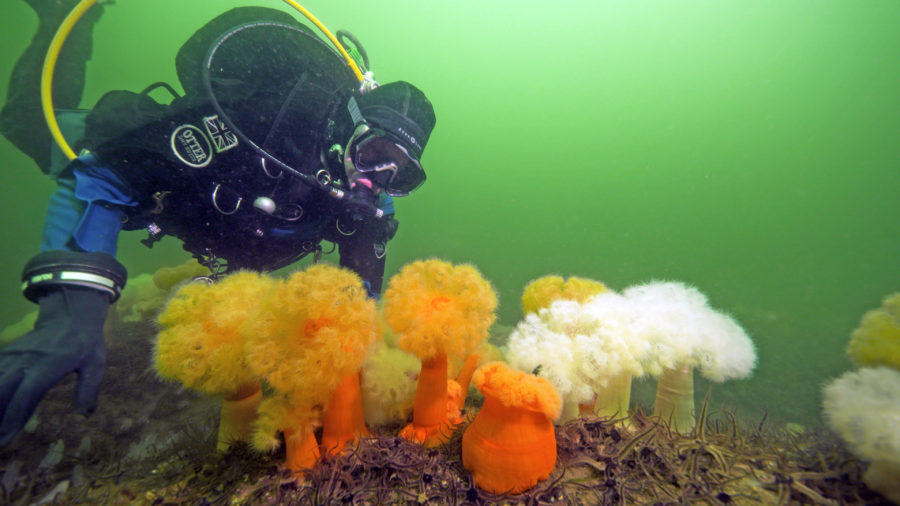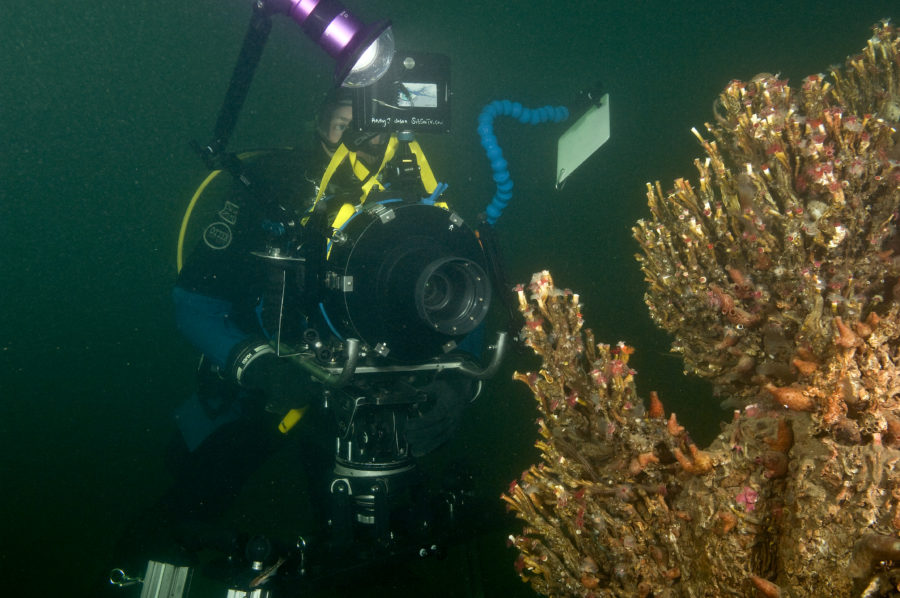An Underwater Garden
Posted on June 5, 2018
We ventured into new territory with our latest BBC Springwatch film. It’s been a fantastic collaborative effort: filmed and narrated by Andy, written by Jackie, edited and produced by the BBC Springwatch team. This film’s all about Andy’s lifelong passion for the underwater world. Thanks to the BBC for giving us the opportunity to create so much of this film ourselves.
Thanks also to Malcolm, Karen and Shona at Loch Fyne Dive Charters for helping to make this all possible. Your boat looks amazing nestled in the glorious scenery. And thanks to James Munt for your extra pair of hands filming topside.
If you missed the show, here’s the link to iPlayer. Our film starts around 39:15 on the timeline.
We hope you enjoy watching!
My quad-pod’s first outing
Posted on March 7, 2018
Over the last 12 months I’ve been developing a rig for filming smooth and precise moving shots underwater, even in macro. Inspired by Hugh Miller’s work on the Japanese puffer fish, I’ve built my own quad-pod and took her on her maiden voyage last week.
The video head is a Ronford-Baker F4. An old design, not intended for underwater use, it’s the only professional video head I’m aware of that is suitably sealed. Ronford-Baker are superb British engineers. Their video heads are built like tanks and most are still in service decades later. Thanks to Jeff Lawrence at Ronford-Baker for his help and advice.
My camera housing fixes to a video-head platform with two different settings. With the camera mounted on top, I can film up to 2m above the seabed. Underslung, I can film inches from the bottom. The four legs ensure an unrestricted view.
The legs were the hardest part of this project and I have to thank my good friend Rob Broadhead at HB Pressings for his support, time and expertise in making the legs, along with many other essential bits and bobs. The legs adjust smoothly and lock firmly into place. The whole thing works a treat.
Thanks also to Graham Saunders, GS Marine Ecology for the photo of the quad-pod in action.
You can watch a few demo shots in this sequence from last week here: pan and tilt, macro, in open water.
____________
Words by Andy
UK Seahorses – Licensed to Film
Posted on February 4, 2018
I have lots of UK marine life footage available for broadcast and my quest is to get it out there so people can appreciate what we have and help protect it. I spend a lot of time with the animals I film – this is the only way to reveal their stories and behaviour. In the UK, weather and poor visibility can make this tricky. The only way I can build up the story is to keep going back when conditions are good and putting in the time underwater.
I always have several projects underway, waiting on weather windows and annual cycles of behaviour. Some stories come easily, others are a slow burn…
One of my slow-burn stories is UK seahorses. I’ve had a licence to film seahorses at Studland for several years now. During the boom years (up to 2010), seahorses were spotted there on most dives. Since 2010, the Studland seahorse population has crashed along with my hopes of filming their life-cycle. If you want to see Studland’s seahorses in the glory days get a look at Steve Trewhella and Julie Hatcher’s super book “In the Company of Seahorses”.
Steve and Julie have been extremely helpful, sharing their expertise, advice, and giving “fins on” tours of the seagrass. This footage was shot with Steve and Julie back in 2015. As you’ll see, these animals are masters of disguise. They blend into their surroundings and sway with the seagrass.
After several years of filming Studland’s seahorses, I’m nowhere near a life-cycle story. But the good news is the Marine Management Organisation (MMO) have now granted me and Steve a new licence to film anywhere in English waters, up to 12 miles offshore.
So if you spot a seahorse we’d love to hear about it. If we can, we’ll come and film reported sightings. With a bit of luck, the UK seahorse film will come together a bit more quickly.
____________
Words by Andy
Serpulid Reefs – Loch Creran
Posted on December 15, 2017
I’m working on a story about Serpulid Reefs in Loch Creran. Last week, I joined Heriot Watt University’s survey team to film these amazing animals. Individual worms are common but the conditions that allow them to build elaborate reef structures are incredibly rare. Worldwide, the best surviving examples are in Scotland.
These tube worms require a great deal of patience to film. I can’t wait to capture them with my macro lens. You’ll notice they’re extremely sensitive to movement and most shots have more than half the worms hiding in their tubes. Given time, I hope to be able to film them fully out, in all their glory.
*** I have added my updated clips to this blog so you can see Serpulid worms fully out ***
____________
Words by Andy
Luftmine – 3D Model
Posted on November 26, 2017
Back in 1995, one of the dive team got back on the boat and reported an unusual object on top of the shipwreck we’d just discovered off Whitby. No one else had noticed it and at first we didn’t believe his description of a shiny silver cylinder that looked a bit like a space craft. Had aliens landed off the Yorkshire coast?
We went back to check it out and I videoed the object. I remember gently polishing the tiny glass porthole with my gloved hand and wondering what could possibly be inside? How could it remain shiny silver and virtually free of marine growth?
I contacted the Imperial War Museum who identified it as a 500kg German Luftmine Type A. It was 5 feet 8 inches long, made of aluminium alloy. Typically dropped from a Heinkel He115 on an artificial silk parachute, it was designed to sit on the seabed until triggered magnetically by a ship passing overhead. Behind the porthole – the one I’d rubbed – was the highly sensitive detonator.
We reported the Luftmine to the Admiralty who decided that 56m was deep enough to leave it where it was. These aerial mines were intended for important naval targets. It didn’t make sense that this 1940s mine was intact on the deck of an early 19th century steamship. There are a few theories but with no hard evidence it remains an unsolved mystery.
Imagine my surprise when Chris Harvey and Richard Brennan of Viewport3 Ltd wanted to use my footage of the Luftmine to demonstrate their 3D technology. Click on the image and move it around. I’m amazed by the possibilities of this technology, which turns video into a powerful 3D scanning tool. If Viewport can create this 3D model with such an old piece of video, imagine the quality they could achieve with today’s Ultra High Definition video.
____________
Words by Andy, 3D model by Viewport3 Ltd


